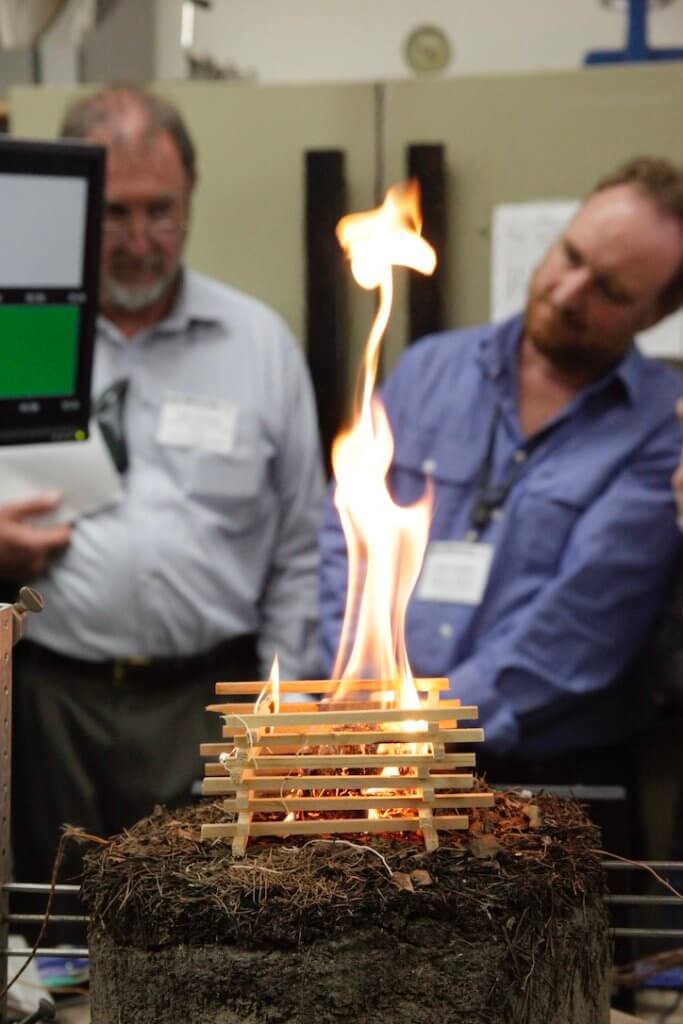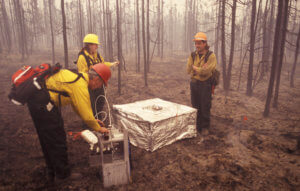
This series was inspired and inaugurated in part by a panel from the IAWF’s Human Dimensions of Wildland Fire conference in December 2018.
By Eric B. Kennedy
Fighting fire is a massively expensive operation. Recent fires around the globe have continued to remind us of the fiscal impact of fire management. Totals for the Camp Fire (including insured and uninsured losses) exceeded $16 billion USD in late 2018 and continue to climb, while CalFire had burnt through over $600 million by November 2018. This sum exceeded its $443 million allocation with much of the fiscal year (which runs until June 2019) still ahead. Experiences in Canada, Australia, and elsewhere have followed similar patterns of high spending on suppression and extensive costs in impact. Wildfire managers and policymakers alike face difficult decisions as these costs continue to mount.
The money invested in suppression, however, vastly outstrips the funds put into two other important parts of the fire management enterprise: preparedness and research. Wise investments in preparation and mitigation – such as conducting fuel treatments nearby interface areas or investing in ember-based mitigation strategies for homes – have the potential to help to reduce skyrocketing suppression costs and property losses down the road. Likewise, investing in fire science provides improved tools for responders and allows for more effective deployment of resources (such as detection technologies or decision-aids for dispatch). Preparedness and science can also help us to achieve ambitions that are more important than economic costs alone: protecting personal property, ensuring responders come home safe, and minimizing disruption to communities as we learn to live with fire.
Science, research, and innovation are hot topics in wildfire management these days. On March 19th, for instance, the Canadian government released the 2019 budget, earmarking $151 million for emergency management, including increasing the “ability to predict and respond to threats through the use of early warning systems, and enhance[ing the] understanding of the nature of the risks posed by floods, wildfires and earthquakes.” And, the next day in Sacramento, California, the state held its first ever “Wildfire and Technology Innovation Summit,” co-hosted by the California Office of Emergency Management, California Public Utilities Commission, UC San Diego, CSU Sacramento, and IBM. The Summit promised to explore “potential technological solutions” to wildfire including artificial intelligence, machine learning, and fire modeling.

Yet, as important as these things are, it’s also easy for researchers, managers, policy makers, and the public to get seduced by the promise of fire science. In this series – this article and a follow up in the next issue – I explore these questions in detail, drawing on a background in the field of science policy to offer some lessons learned from other sectors.
- Can more funding for fire science help to solve our wildfire woes?
- Are the existing funding strategies good enough and simply in need of more money, or do we need to explore new options?
- What are the best practices for making investments do more in fire science and fire research?
These questions were considered in a panel discussion at the Human Dimensions conference in December 2018 and are worth debating more broadly among the wildfire management community as a whole.
The Myth of More Money
Before we can explore how fire science is funded, we need to start by considering two common myths and misunderstandings about the topic. The first myth is relatively straightforward: just like in science, research, and innovation more broadly, it’s easy to believe that ‘more money’ will directly translate into better science, better results, and better fire management. While it would be politically expedient for me to believe and advocate for this (I am, of course, an academic researcher who would love more grants to be available in the area!), the reality is a whole lot more complicated.
Much like we’ve learned the importance of understanding fire as one of the many interrelated components in a forest ecosystem, it’s also worth understanding the ‘research ecosystem’ is similarly complex. In the research ecosystem, inputs include funding, but also personnel (researchers and the next generation of trainees), collaborative relationships (partnerships between researchers and practitioners), competing incentives (like pressure from superiors to publish to retain one’s job in academia, or certain topics being ‘sexy’ for funding), and systematic biases (like which demographics have historically been underrepresented in academia, or which topics are considered important or unimportant). The research ecosystem also has a large number of ‘species’ that conduct studies and produce innovations, including universities, governments, and private companies, each of whom has different priorities, inclinations, and biases.
This is why simply injecting more money into the system doesn’t guarantee better science. Additional funds can be squandered, for instance, in the accidental duplication of existing research, especially where there are disconnects between what is being done in different institutes, between the work of universities and private companies, and spread across different continents. There can be significant gaps between the topics that researchers want to pursue and the questions that are actually important to wildfire managers. Similarly, there can be a disconnect between what practitioners want (i.e. a decision-making aid that can help to reduce liability) and what scientists are actually able to provide. In addition, all too often research is metaphorically ‘dropped off’ for practitioners to use but is never actually taken up for a variety of reasons. In other words, how money is spent is just as important as how much money is injected in the first place.
Even if we can increase the production of good fire science, there’s a second myth: that scientific and technological innovation will resolve the big challenges that we face in fire management. Of course, this can happen. The International Crown Fire Modelling Experiment and a multitude of other research projects have translated into a far more complete understanding of fire’s potential and behavior on the landscape. Similarly, technological innovations in aircraft, retardants, and communication technologies have resulted in more effective firefighting operations on the ground.
Improved computational models, for instance, can tell us how fire is likely to behave under certain conditions, whether a fuel treatment in a specific location might slow fire spread, or where fires have started relative to transmission lines. They cannot, however, inform the inherent values-based questions that lie beneath:
- How conservative or risk tolerant should we be when we deploy firefighters in light of predicted fire behavior?
- How much we should be willing to spend on that fuel treatment?
- Who ought to be held financially responsible for the new ignition?
These are questions of values, not of scientific fact.
It’s critical to distinguish between science and values, even though the two are deeply intertwined. As scholars like Daniel Sarewitz and Roger Pielke Jr. often point out, it’s tempting to try to use science to resolve values debates. Take, for instance, the calls we hear frequently to limit global warming to 1.5 or 2 degrees Celsius (lest we face the consequences). Science can help us to understand the consequences of 1.5 versus 2.0 versus 3.0 degrees of warming with respect to, say, sea level rise or wildfire season length. But, try as people might, it cannot tell us which of those values is an ‘acceptable’ level of warming. Should humanity be okay with 1.5 degrees? Or, is that too much or too little? Similarly, technological innovation produces the wind turbines and nuclear plants that might help to remake our energy system, but it cannot tell us which of those is ethical or legitimate or acceptable to deploy.
To offer an example that’s closer to home, imagine that we invested money into wildfire science and created a near-perfect fire behavior model. With this model, we could test possible fuel treatments against simulated fires to determine what protective effects the treatments had for nearby communities. This model might be able to tell us whether a given treatment was likely to prevent a specific simulated fire from impacting a nearby community. But the model couldn’t tell us anything about whether we ought to actually undertake that treatment, how much was worth spending to perform it, or what priority it ought to be given against other treatments.
“Wait,” some readers might be saying. “We could just compare all the different possible treatments against this fire and rank them in terms of the size of their effect!” That’s true – but it still wouldn’t tell us where in that order we say ‘enough is enough’ given a limited amount of funding. And, more importantly, it’s likely that most managers on the ground already know which of these treatments are a high priority for community protection. The model doesn’t provide some objective, surprising truth about the world. Rather, the model simply provides evidence for the treatment we want to justify – evidence that can be tweaked by altering the simulation to attain our desired ends.
Not Bad News for Science
Lest this sound like an attack on science, research, and innovation in wildfire management, it’s important to be clear about what I am – and am not – presenting for your consideration. First, I’m stating that we need to be careful about the allure of calls for more research funding alone. Injecting more money into wildfire research doesn’t guarantee better outcomes, either in terms of data quality or relevance for fire managers. Second, I’m suggesting that we need to be careful to reflect on what science can and cannot provide for us. Science can help us better achieve our objectives (like putting out fires as quickly as possible whatever the cost, or restoring fire to the landscape for ecological purposes), but it cannot tell us what our objectives ought to be. Those are debates about values that must be brave enough to express explicitly: Just how much are we willing to spend to protect communities? Who is responsible for paying? How much risk is tolerable for firefighters, infrastructure, and ecosystems?
I’m not arguing that fire science isn’t important, or that we shouldn’t increase our funding for research. I emphatically agree with both of those positions. But we need to be careful to inject this funding in wise and effective ways and to understand what questions science can and cannot answer for us. A healthy research ecosystem is a critical part of being able to manage fires according to our desired strategies. Even though it can’t answer what or why it can provide effective guidance in how we achieve those ends. This ecosystem is complicated – and current strategies may have significant limitations.
Some of these limitations were discussed at the recent International Association of Wildland Fire’s fifth Human Dimensions of Wildland Fire conference in Asheville, North Carolina in December 2018. At the “Research Nexus Panel” hosted by Noreen Krusel from the Australasian Fire and Emergency Services Council, panelists Sarah McCaffery (US Forest Service), Richard Thornton and David Bruce (Bushfire & Natural Hazards CRC), and Stacey Frederick (California Fire Consortium) provided experience-based insights into the funding challenges facing the wildfire science sector. The discussion was lively, provocative, and informative, with several different kinds of limitations coming up for discussion: the timing and length of funding, the social impacts of the money, the proposal and granting process, and coordination between different actors.
In the next issue of Wildfire, I’ll discuss these additional challenges in detail and offer some ideas about how we can solve them to improve the fire research ecosystem. The answer isn’t just ‘more science’ or ‘more money,’ but instead thinking critically and systematically about who we fund, what projects we undertake, and how we select between options. In the meantime, I’d encourage you to reach out via the contact information below to share your views on the topic so far.
This is the first in a series of articles by Eric Kennedy exploring wildfire science, research, and funding.
In the next issue of Wildfire, Kennedy will discuss the challenges facing wildfire science, offering further analysis on the opportunities available for adapting and re-focusing fire-science funding models, and provide some suggestions on how long-term support of wildfire science can integrate with and support the application of science by practitioners in the field.
About the Author

Eric Kennedy is an Assistant Professor in the Disaster and Emergency Management program at York University in Toronto, Canada. With a Ph.D. in the Human and Social Dimensions of Science and Technology from the Consortium for Science, Policy & Outcomes at Arizona State University, his research focuses on how experts, agencies, and institutions manage wildfire – and deal with conflicting views on this contentious topic. He teaches courses in the ethics, sociology, and psychology of emergency management, working closely with practitioners in the field in Canada and beyond to train the next generation of emergency managers. You can reach him at [email protected] or on Twitter at @ericbkennedy.
